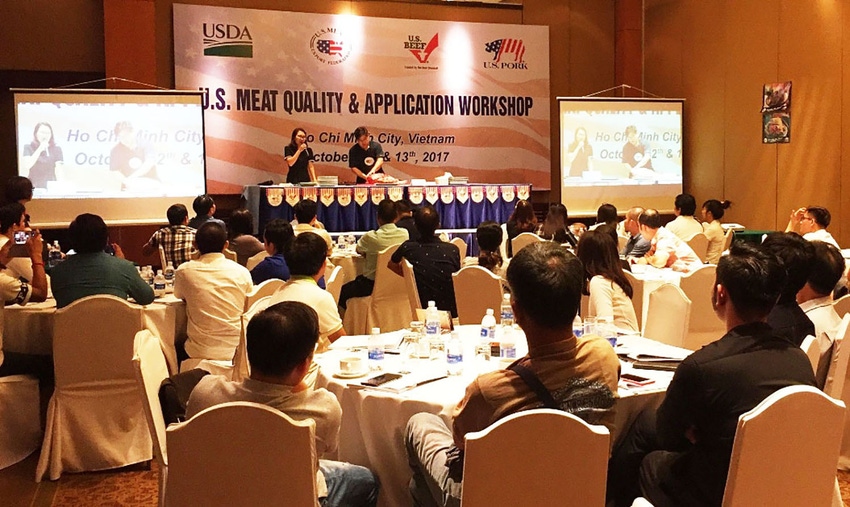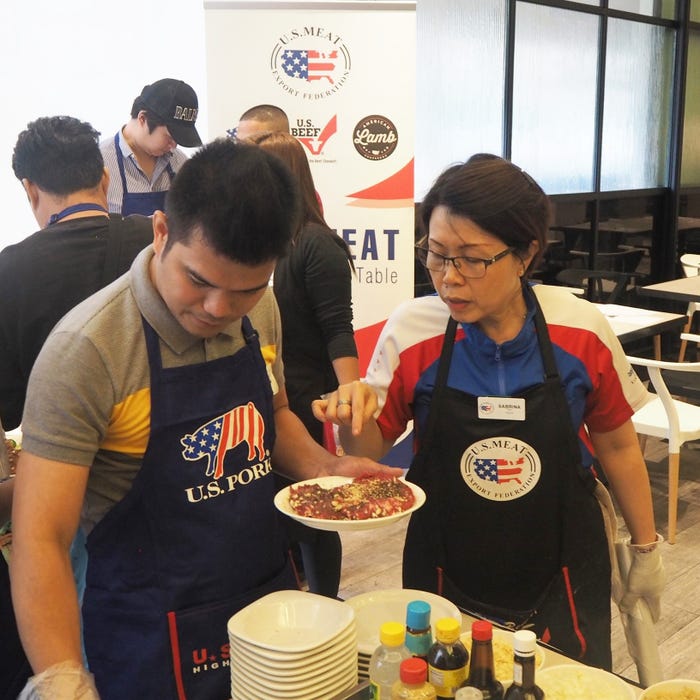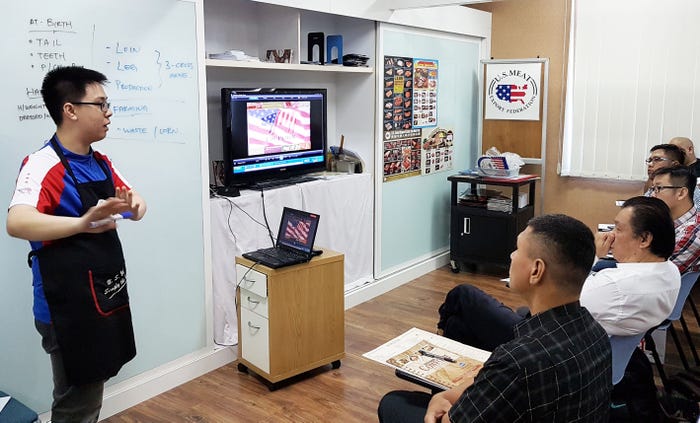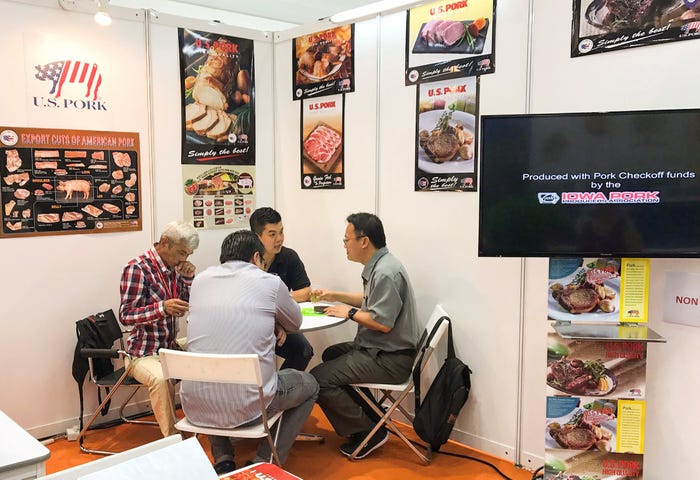To build further momentum and expand the range of buyers in the ASEAN region, the U.S. Meat Export Federation recently showcased U.S. pork in some key venues.
January 10, 2018

The countries that comprise the Association of Southeast Asian Nations are a rapidly growing market for U.S. pork. Through November 2017, pork and pork variety meat exports to the ASEAN region were up 15 percent year-over-over in volume to 43,815 metric tons (mt), while value climbed 31 percent to $119.5 million. One of the U.S. industry’s largest destinations for pork variety meat exports, it trails only China/Hong Kong, Mexico and Canada.
To build further momentum and expand the range of buyers in the ASEAN region, the U.S. Meat Export Federation recently showcased U.S. pork in some key venues. Funding support for these activities provided by the Pork Checkoff and the USDA Market Access Program.
In a unique and innovative endeavor, USMEF’s Korea office teamed with its ASEAN staff to conduct a U.S. Red Meat Quality and Application Workshop in Vietnam. The two-day event attracted 115 importers and retailers from across Southeast Asia to the Equatorial Hotel in Ho Chi Minh City with demonstrations on Korean-style meat cutting.
“Korean-style meat dishes are popular in many markets in Southeast Asia, so it is important to share how U.S. red meat enhances the quality of the dining experience,” said Junil Park, USMEF retail specialist in Korea, the event’s training instructor. “The two USMEF offices planned an informative session to highlight the U.S. cuts that work best and would be most attractive to the audience. This was a great approach to promoting U.S. pork, and we hope to build upon it in future workshops.”

Cuts highlighted at the workshop included bone-in U.S. pork loin, shoulder butt and brisket soft bones. Following the cutting demonstrations, participants were shown different cooking methods by USMEF regional chef Melvin Ho. They also interacted with five local importers who were invited to display their products at the workshop.
“Inviting the importers opened doors for the retailers and foodservice operators in attendance, giving them a look at their options for acquiring U.S. pork and a choice of different suppliers,” said Park.
Before the Ho Chi Minh City workshop, USMEF hosted two dozen importers from the Philippines and Cambodia – markets on opposite ends of the U.S. red meat import spectrum – for visits to restaurants and supermarket chains in Vietnam, to show them how U.S. pork is used on foodservice menus and displayed at retail. While the Philippines is already well-established as the largest ASEAN destination for U.S. pork, Cambodia’s potential is only beginning to emerge.
Importers, distributors and foodservice companies in the Philippines gained a better understanding of the value and availability of U.S. pork at a U.S. Meat Culinary Training Camp, which USMEF conducted in Pampanga – the federation’s first event in that city since 2012.
“Pampanga is known as the culinary capital of the Philippines because of its reputation for excellent food,” explained USMEF ASEAN Director Sabrina Yin. “Since our last culinary training camp, Pampanga has seen a rapid increase in the number of hotels and restaurants.”
USMEF invited three local importers – Alternatives Food, Hightower Inc. and Vanguard Distribution and Logistics – to select sales staff and valued customers to attend. The two-day culinary training was attended by a total of 31 participants. A cooking demonstration by Chef Jose Carmelito Quizon included information on native Kapampangan cuisine and how it was influenced by colonization. Chef Ho opened the second day of the culinary training with a presentation focused specifically on U.S. pork.

On the day following the culinary camp, USMEF teamed with the USDA Foreign Agricultural Service in Manila and the Association of Hotel and Restaurant Purchasing Managers of the Philippines to organize an event at the Solaire Resort and Casino in Manila. The agenda included seminars pairing U.S. meat with California wines and a U.S. product showcase trade reception. The event was attended by nearly 100 purchasing managers from hotels and restaurants in Manila and the surrounding area.
Because of their predominately Muslim populations, Indonesia and Malaysia present unique challenges for the U.S. pork industry. However, growth opportunities for U.S. pork definitely exist in both markets. Along with chefs who work for the company’s clients employees of Indonesia-based importer Scenia were recently chosen to participate in a training seminar at USMEF’s culinary facility in Singapore.

a system to Indonesian chefs and importers
Chef Ho gave the group a detailed presentation on U.S. pork production and how it compares with production systems in competing countries.
“The pork production systems vary greatly around the world, so it is important for us to share insights into the U.S. system, which is of the highest quality and delivers a very consistent product,” said Yin. “Giving the decision makers that insight is an advantage for U.S. pork when it comes time for them to buy.”
U.S. pork cuts featured at the seminar included CT butt, jowl and belly.
USMEF also sought new customers for U.S. pork at Food and Hotel Malaysia; a biennial trade show held late last year in Kuala Lumpur.
Malaysia’s per capita pork consumption is estimated to be about 17 pounds per year. But when considering the country’s population is about 60 percent Muslim, this means non-Muslim Malaysians consume about 43 pounds of pork annually.

“A growing number of independent restaurants serve Malaysia’s non-halal consumers, including thousands of Chinese establishments,” she said. “USMEF must keep U.S. pork on the minds of consumers and restaurant and foodservice operators. We won’t make huge strides overnight, but we can grow exports of U.S. pork steadily by reminding Malaysians about the quality and the availability of the product.”
About the Author(s)
You May Also Like



